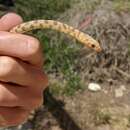ar
الأسماء في صفحات التنقل


Diurnal and crepuscular, with activity extending well after dark in summer. In Siwa Oasis shed skins of several individuals were found under a stump of a single palm tree during spring, perhaps indicating communal hibernation.
Least Concern
A medium-sized, slender snake, not exceeding 1,000 mm in total length. Largest Egyptian specimen has a total length of 845 mm.Tail relatively long, tail / total length= 0.24-0.36. Nine supralabials, fifth and sixth enter the eye, 197-215 ventrals, 95-106 subcaudals, 19 scale rows around mid-body, anal divided. Usually a longitudinal nuchal stripe on the dorsal side of the neck. Dorsum light gray with a longitudinal row of large, dark-gray, rounded spots, alternating with two lateral series of smaller spots. This pattern fades posteriorly, the terminal third of dorsum being plain gray. Venter white, with dark spots on the margin of most anterior ventrals. Pattern more contrasting in young animals.
Northern Egypt, north of 28°N. West of the Nile it is found throughout the western Mediterranean coastal plain, Wadi El Natrun, and Siwa Oasis (probably also the northern rim of the Qattara Depression). In the Eastern Desert found north ofWadi Araba. A single specimen reported by Rehak and Osborne (1988) from Wadi Showak, in the Gebel El Shayeb-Qattar area is most likely referable to P. saharicus (based on the lack of suitable habitat). Goodman and Hobbs (1994) only reported the latter species from the same area. In Sinai it is widespread in the north, except for the dune fields. In the south it is apparently less widespread and has been recorded from the St. Katherine area and from Wadi Watir. Two other specimens from St. Katherine, which Marx (1968) referred to this species are in fact P. saharicus.
Northern Cyrenaica (Libya), Egypt, Israel, to Iraq and northern Saudi Arabia.
Inhabits open hilly deserts with modest vegetation. Unlike Platyceps saharicus this species generally prefers more open situations, such as gravel plains, stony plateaus, and sometimes in fairly sandy areas. It also penetrates mountainous regions via wide wadi systems. Reaches up to 1,500 m and is present in the vicinity of the town of St. Katherine in South Sinai.
Fairly common and widespread. Its open habitats are prone to be affected by activities such as soil quarrying and off-road vehicles. Fairly common in the pet trade.